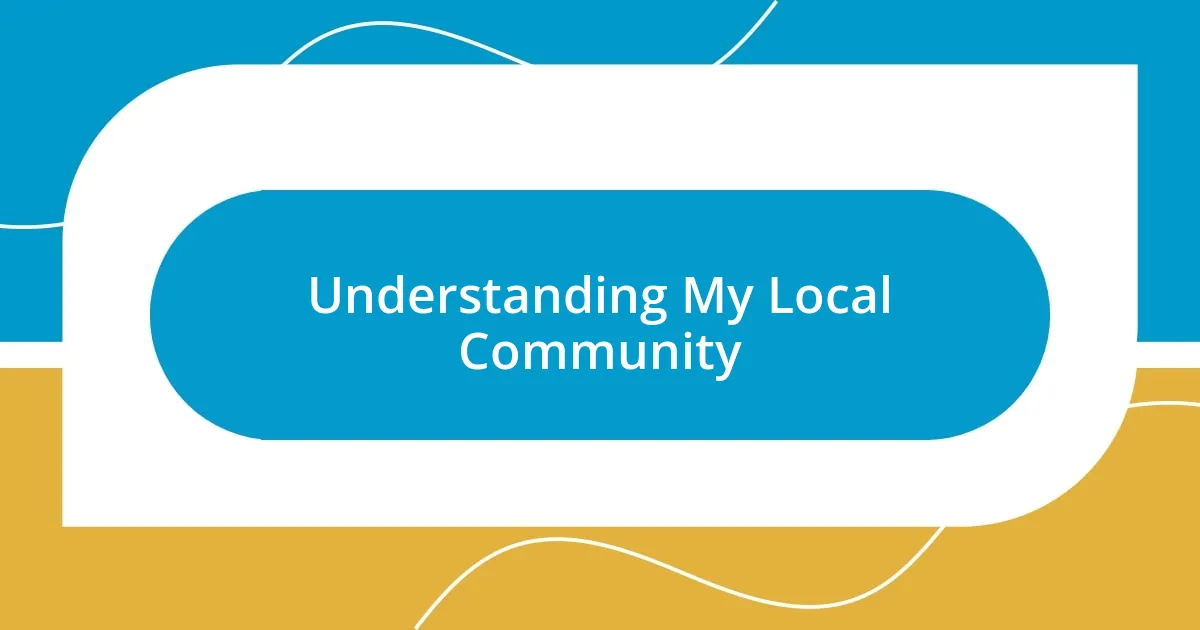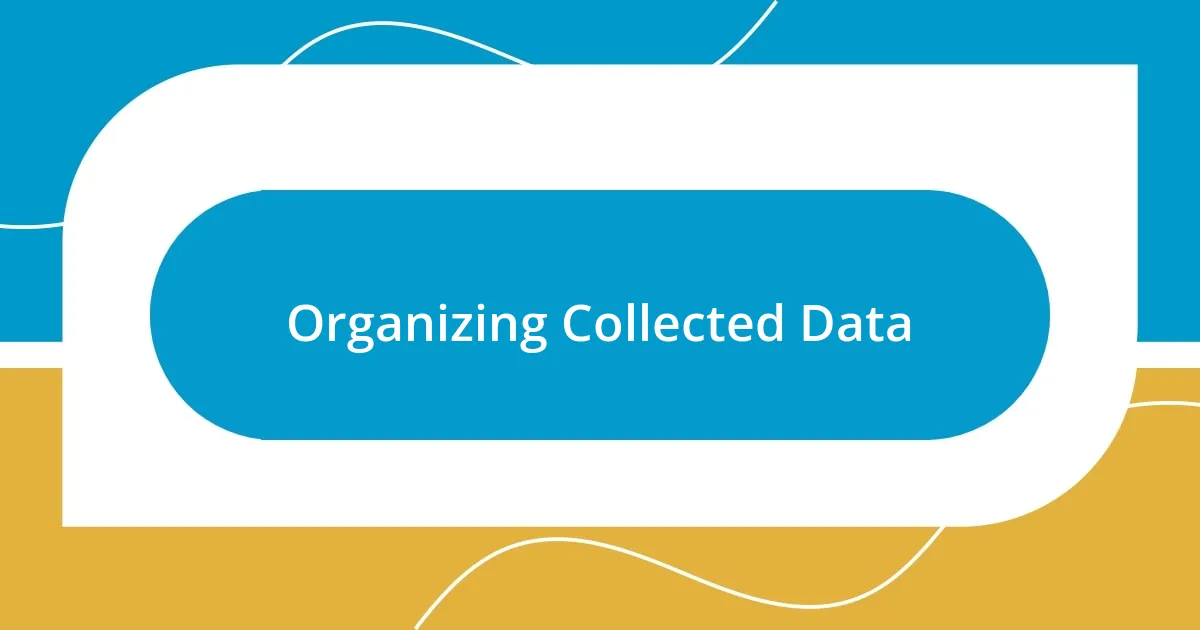Key takeaways:
- Engagement with local residents through conversations and events leads to a deeper understanding of community narratives.
- Setting flexible documentation goals allows for richer, unexpected storytelling moments.
- Utilizing a mix of digital and analog tools enhances the documentation experience and emotional connections.
- Sharing findings online transforms personal insights into a collective community experience, fostering dialogue and collaboration.

Understanding My Local Community
Understanding my local community has truly been a journey of discovery. I remember the first time I wandered through a neighborhood festival, where the vibrant colors and laughter created an atmosphere I didn’t want to leave. It made me wonder, how many stories are hidden among the faces I see every day?
As I chatted with a local artist showcasing their work, I learned about their creative process and how their art reflects the struggles and triumphs of our community. This experience deepened my appreciation for the layers of history embedded in our surroundings. I often ask myself, how can we begin to understand a place without connecting to the people who shape it?
There’s something incredibly powerful about sitting in a local café, eavesdropping on snippets of conversation that reveal the everyday challenges and dreams of my neighbors. Each chat feels like a small window into lives that are both similar and strikingly different from my own. I find myself pondering, what do these shared experiences tell us about our collective identity?

Setting Documentation Goals
Setting documentation goals is crucial for any project focused on capturing the essence of a community. I clearly remember when I first decided to document my local community; I set specific goals to guide my efforts. These ranged from understanding the cultural diversity to capturing stories that resonate with the residents. This clarity kept me focused and motivated.
As I navigated this journey, I discovered that flexibility in my goals was equally important. I started with a rigid outline, but soon realized that unplanned moments often yielded the richest stories. For instance, I stumbled upon an impromptu dance party in the park that was not part of my initial plan, yet it became one of my favorite documents of community spirit.
In essence, setting documentation goals requires a delicate balance between structure and spontaneity. Each goal shaped my experience, yet adapting them allowed me to gain deeper insights into my community’s true character. It’s like setting out on a road trip; having a destination is essential, but the unexpected detours often become the most memorable parts of the journey.
| Documentation Goal | Example |
|---|---|
| Cultural Diversity | Interviews with local artisans |
| Community Events | Documenting the neighborhood festival |
| Personal Stories | Capturing a local resident’s journey |

Choosing Documentation Tools
Choosing the right tools for documentation was a pivotal aspect of my journey. Initially, I found myself overwhelmed by the plethora of options available, from mobile apps to traditional notebooks. Reflecting on what felt most natural to me became essential. For example, I discovered that using my smartphone’s voice memo feature allowed me to capture raw, spontaneous conversations with people in real-time. The candidness of those moments would often reveal emotions that written notes just couldn’t convey.
When selecting tools, I recommend considering a mix of digital and analog methods. Each tool brings its own strengths to the table. Here’s a quick breakdown of what worked for me:
- Voice Memo Apps: Perfect for capturing live conversations.
- Photography: Still images often tell powerful visual stories.
- Journals: Writing allows for deeper reflection and the documentation of emotions.
- Social Media Platforms: Great for sharing experiences and gathering community feedback.
- Videos: They encapsulate movement and sound, making stories more dynamic.
This blend of tools ultimately enhanced my documentation experience and helped me connect more meaningfully with the community.

Capturing Key Community Events
Capturing key community events has always been a thrilling part of my documentation project. I remember attending the annual neighborhood block party, where laughter and the scent of barbecue filled the air. There was a moment when I witnessed a group of kids energetically competing in a three-legged race. Their enthusiasm was contagious, and I couldn’t resist grabbing my camera to capture their joy. Isn’t it incredible how such gatherings make you feel part of something bigger?
What truly stood out was the storytelling aspect woven into these events. One afternoon at a cultural festival, I found myself engrossed in a conversation with an elder who shared tales of his youth. As he recounted the vibrant history of our town through the lens of past celebrations, I felt my heart swell with pride. It was more than just documentation; it became a shared moment that connected generations. Have you ever felt that profound connection with someone over a shared story?
Some of the most memorable images I’ve taken were from spontaneous events. One evening, as I was leaving a local café, a pop-up concert erupted in the street. The crowd instantly joined in, swaying and singing along, transforming a regular night into a festive celebration. I decided to record that magical atmosphere; the energy was palpable. Events like these remind me that sometimes the best moments are unplanned, capturing genuine human connections in ways we might not expect. Don’t you think those surprise encounters often make the most lasting impressions?

Engaging with Local Residents
Engaging with local residents can be an enriching experience that transforms your understanding of the community. When I first started, I realized that simply showing up wasn’t enough. Attending local meetings at the community center felt daunting at first, but initiating conversations with fellow attendees opened doors to so many stories. I often found myself talking to a retired teacher who had a wealth of knowledge about the neighborhood’s history. Isn’t it amazing how a simple chat can unfold layers of community narratives we never knew existed?
Building meaningful connections requires more than just the exchange of information; it involves actively listening and being present. One morning at the farmer’s market, I struck up a discussion with a local farmer who was passionate about sustainable agriculture. His eyes lit up as he spoke about his methods and the challenges he faced. I couldn’t help but feel inspired by his dedication to the land and the community’s well-being. Doesn’t it warm your heart to see such passion in action?
Another time, while volunteering at a local shelter, I met a group of residents who had transformed their lives through shared effort and resilience. I learned about their journeys and the immense support they provided each other. It was a poignant reminder of the strength found in community ties. Have you ever felt that camaraderie when working side by side with others toward a common goal? In these encounters, I discovered that engaging with local residents isn’t just about gathering stories; it’s about fostering connections that breathe life into our community fabric.

Organizing Collected Data
Organizing the data I collected felt like piecing together a vibrant puzzle of my community. I found it helpful to categorize my findings into themes, such as local culture, community concerns, and historical significance. For instance, I created a digital folder specifically for stories related to local businesses, each file containing photos and interviews that highlighted the unique character of the area. Isn’t it interesting how a little organization can transform chaos into clarity?
One practical approach was using a spreadsheet to track events and interactions. I dedicated columns for dates, locations, and key points from conversations. This method not only helped me recall specific details but also allowed me to recognize patterns in what residents valued most about their community. Reflecting on this process, I wondered, how often do we overlook the importance of keeping a record that tells a story?
As I continued organizing, I felt an emotional connection grow with each piece of data. Each story gathered evoked memories of shared laughter, challenges faced, and dreams voiced. I began to see how these narratives intertwined, painting a larger picture of the community’s heart and soul. Isn’t it fascinating to think that behind every statistic or observation lies a rich story waiting to be told? In the end, I realized that thorough organization was about honoring these stories, ensuring they wouldn’t fade away but instead flourish in their shared legacy.

Sharing My Findings Online
When it came time to share my findings online, I felt a mix of excitement and trepidation. I decided to create a blog where I could visually showcase the stories I had gathered, complete with photographs and snippets of interviews. It was fascinating to see how a simple platform could transform personal insights into a shared experience. Isn’t it incredible how technology allows us to connect with a wider audience beyond our immediate surroundings?
To engage my readers, I chose to incorporate multimedia elements into my posts—videos of local events, audio clips of interviews, and even social media snippets from conversations I’d had. I remember the thrill of capturing the laughter of children at a community festival and then watching those moments resonate with my followers. Hearing their responses made me realize that sharing findings isn’t just about relaying facts; it’s about sparking conversations and building a community of shared interests and experiences. Have you ever experienced a shift in perspective after connecting with others over a shared story?
As my blog gained traction, the feedback was overwhelmingly positive, and I realized that my storytelling had the power to inspire and unite. Readers began sharing their own experiences, enriching the narrative with their thoughts and memories. This collaborative exchange deepened my appreciation for the community. It became clear to me that when we share our findings online, we open doors to understanding and reflection, transforming our individual journeys into a collective tapestry of shared knowledge and passion. Isn’t it wonderful how one voice can echo through many?














